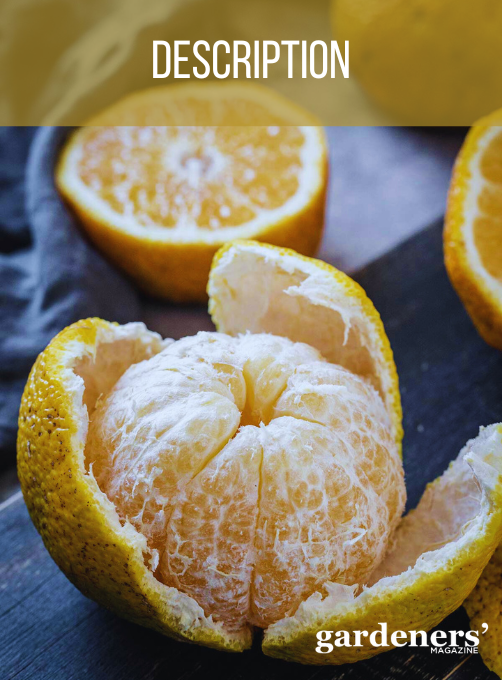Infamously named- Ugli fruit (often referred to as a Tangelo) is a hybrid citrus, primarily a cross between a grapefruit and mandarin, initially discovered growing wild in the Jamaican hills. Over the decades, it has become a vital citrus crop in the Caribbean, South America, Mexico, and Central America. It derives the designation “ugli” due to its wrinkled appearance, first coined by an importer as “that ugly fruit.”
Ugli fruit trees are also referred to as tangelo or uniq fruit trees due to their unique flavor profile that combines tartness with sweetness.
What is Ugli Fruit?

Ugli fruit is a citrus hybrid that is known for its unique flavor and texture. The fruit has rough, bumpy skin with yellow-green to bright orange coloring. It has a teardrop shape and is typically larger than a grapefruit but smaller than an orange. It has a sour-sweet taste similar to both fruits.
Just like most citrus fruits, the flesh is orange and divided into sections. Courtesy to its taste, Ugli fruit can be used in juices, jams, marmalades, salad dressings, and more. It’s also popularly blended into smoothies or made into sorbet.
Being a great source of Vitamin C and potassium, makes it a nutritious snack or addition to any meal. Be sure to add Ugli fruit slices to your next breakfast bowl or lunch salad for flavor and nutrition.
History and Origins:
Ugli fruit is a product of an accidental and chance seedling found growing naturally in Jamaica in the early 20th century. The exact origins of the fruit are disputed and unclear. However, it is thought to have originated from a cross between an orange, a tangerine, and a grapefruit.
It was first introduced outside of Jamaica in 1924 by Harold Moore, owner of a citrus nursery in England. He randomly addressed it as “Ugli,” after its unattractive appearance.
The Ugli fruit quickly gained popularity because of its unique taste and ease of peeling. Its flesh is juicy and sweet-tart with a hint of grapefruit flavor. Over time, Ugli trees were grown in other regions worldwide, including Cuba, Florida, Mexico, and California.
Today, Ugli fruit is widely available in Jamaica and other parts of the Caribbean, as well as certain regions of North and South America. It can be found in grocery stores across the United States. It’s versatile taste allows it to be added to a variety of preparations, such as smoothies, cakes, salads, and sauces.

Description:
The ugli fruit is typically round or oval-shaped and can measure up to 8 inches in diameter. Its skin is yellow to orange-yellow and very thick (up to 1/2 inch), making it difficult to peel without cutting into segments. Its flesh is tart and juicy, with a unique flavor profile that is neither sweet nor sour. The pulp contains many seeds, which are edible but typically discarded when consumed.

Flavor Profile:
In this case, the “uglier” it looks the better(or sweeter) it tastes. The Ugli fruit has a unique flavor profile that resonates with a blend of sweet and tart. It has a soft, juicy texture with undertones of citrus and pineapple. As mentioned earlier, the sweetness levels vary depending on how ripe the fruit is.
The taste can also vary from region to region, so it’s best to try it if you can find one near you. Overall, the Ugli fruit is an enjoyable snack that has a unique flavor and the versatility of being added to a variety of meals and preparations.
Health Benefits:
The Ugli fruit is packed with nutrients and health benefits, making it an excellent choice for anyone looking to get their daily dose of vitamins and minerals.
It is a good source of Vitamin C, which works as a great antioxidant and which helps in shielding against colds and other illnesses. It also contains significant amounts of dietary fiber, which helps regulate digestion and keep you feeling full longer.
The Ugli fruit’s high water content makes it a great way to stay hydrated throughout the day. Additionally, it contains small amounts of all essential minerals to promote overall health. Its antioxidant properties can help fight inflammation caused by free radicals in the body.
Being an excellent source of vitamins and minerals, it becomes a great addition to any diet. Add it to salads and smoothies, or eat it as a snack! It tastes delicious and will provide you with some great health benefits.

Cultivation:
The Ugli fruit requires very little maintenance and can be grown in a variety of soil types. It thrives best in loamy soils with good drainage but will grow well in neutral to slightly acidic soils with a pH range of 6.0-7.5 for optimal growth. In tropical climates, the tree blossoms throughout spring and bears fruit during summer and fall when temperatures are warmest.
When growing an ugli tree, adequate space is important for proper sun exposure and air circulation, which will help to prevent disease and pest infestation.
Pruning is essential for keeping the tree healthy, as it encourages new growth and helps to open up the canopy of foliage for better light penetration. A mature plant should receive at least 6-8 hours of direct sunlight daily. However, the tree is drought tolerant and can withstand periods of dry weather, so it’s better to be watered regularly.
Regular fertilization is necessary for optimal fruit production. Use a balanced fertilizer with an actual nitrogen, phosphorus, and potassium ratio. Once fully mature after three to five years, the Ugli tree will bear large clusters of round fruits that measure up to 8 cm in diameter. The skin color ranges from light green to yellowish-orange when ripe and has a uniquely bumpy texture.
Harvesting:
Harvesting is done when the fruit reaches a size of 5 to 7 cm in diameter. It should feel soft and not too hard. Ensure that the stem does not break off, as it can cause the fruit to rot quickly. Harvesting should be done cautiously as the skin can easily bruise or puncture if handled roughly.
The fruits are picked from trees while still on the branch and placed into crates for transport. Care should be taken to prevent bruising or damage during harvesting, packing, and shipping. After harvesting, Ugli fruits can last up to two weeks when stored at room temperature and refrigerated for up to one month.
Where Does Ugli Fruit Grow?
These fruits are mainly grown in the tropical and subtropical regions of Central America, Mexico, South Florida, Jamaica, and other Caribbean islands. The main concentration for commercial production of Ugli fruit is in Jamaica, an important crop for many generations.
Ugli fruit is also found throughout the West Indies in countries such as Barbados, Trinidad & Tobago, Guyana, and Grenada. It can be seen growing wild along roadsides and fields all over the islands. Florida has emerged as a major producer of Ugli fruit over the years, with attempts being made by California and Arizona too.
Other countries that grow Ugli fruit include Brazil, Peru, Ecuador, and Honduras. In some areas of India, it is grown as a garden plant or in pots on balconies in cities like Mumbai. There have also been reports of sightings from as far away as Africa and Australia.
Ugli fruit can be successfully cultivated in warm climates where temperatures never drop below 10°C (50°F). This means it is unsuitable for temperate areas such as the United States, Canada, or Europe. It can also be grown indoors in containers with the correct care and attention. In summary, tropical or subtropical regions are best suited for growing Ugli fruit.

Where to Buy?
The best quality Ugli Fruit can be found in specialty stores, farmers’ markets, and online. If you are looking for top-quality fruit, your best bet is to visit a local farmers market or specialty store specializing in tropical fruits.
Online retailers such Instacart, Walmart, and Etsy often have good selections of Ugli Fruit. You may also want to contact local importers or growers in your area to see if they have any fresh oranges available. Ugli fruit is the most popular in states such as Illinois and Minnesota, often being regarded as the favorite fruit of Illinois due to high consumption rate.
Finally, you could even grow some plants if you have a sunny spot outdoors! With proper care and dedication, you could soon be feasting on delicious Ugli fruit all year round.
Things to Keep in Mind When Buying:
1. Check for ripeness: When ripe, Ugli fruit should be slightly soft to the touch, with a fragrant aroma.
2. Look for blemishes and spots: The fruit should be relatively free of spots or blemishes; any visible signs of decay can affect its taste.
3. Smell it: A ripe fruit has a distinct sweet-tart fragrance that is hard to miss.
4. Taste it: The flavor of ugli fruit is sweet and tart, with hints of citrus notes like lemon or grapefruit. If it tastes sour or bitter, it may not be ripe yet and will need more time on the counter before eating.
5. Avoid overripe fruits: An overly soft fruit may be past its prime and could have an off-taste. Choose one that feels slightly firm but still gives way when lightly pressed with a finger.
How to Store?
The best way to store Ugli Fruit is in a cool, dark place with good air circulation. Store the fruit at room temperature and away from direct sunlight or heat sources. Keep the fruit in a single layer to get air on all sides if possible. The ideal humidity for storing Ugli Fruit is between 50-70%.
Check for signs –
It’s important to check your fruit regularly for any signs of spoilage, such as soft spots, mold, or an off smell. Remove any spoilt fruits immediately to prevent contamination of other stored fruits.
If not consuming the fruit within a few days, freezing for later enjoyment is feasible. To do this properly:
- Wash the fruit with cold water and then pat it dry with a paper towel.
- Slice or chop the fruit as desired, and then place it into an airtight container or freezer bag.
- Squeeze out as much air as possible from the bag before sealing it shut.
- When freezing your fruits, label each one clearly and include the date of freezing so you know how long they have been stored.
- Frozen Ugli Fruit can last up to 8 months in the freezer.

Various Culinary Uses:
Ugli Fruit can be a great addition to recipes that involve other fruits. It has a tangy flavor and unique texture that adds an interesting complexity to dishes. You can add Ugli Fruit to smoothies, salads, sauces, jams, pies, crumbles, salsa, or even just fresh in slices with some honey or a squeeze of lime juice.
You can also use Ugli Fruit to add flavor and nutrition to savory dishes. Try adding it to a salad of roasted vegetables or as an ingredient in stir-fries. It pairs well with proteins like chicken, fish, and tofu. You could also create sauces using diced fruit pieces for extra zest.
The possibilities are endless – use your imagination and let the flavors guide you. Have fun experimenting with Ugli Fruit in the kitchen, and enjoy all the delicious creations you come up with.
Conclusion:
Ugli Fruit is a unique and delicious citrus fruit that can be used in sweet and savory recipes. It has a tart flavor and juicy texture, making it an excellent dish addition. From smoothies to salads, jams to pies, Ugli Fruit adds an extra kick of flavor you won’t find anywhere else!
So why not give it a try for yourself? You’ll surely love the results.
FAQs
Q.1 When is Ugli fruit available?
Ugly fruit is usually available from late November to April.
Q.2 How to cut and eat Ugli fruit?
It can be easily peeled off into individual pieces or cut into sections and scooped with a spoon. It can be consumed as a snack, dessert, or juice and can even be added to a variety of other foods and recipes.
Q.3 Where is Ugli fruit grown?
Primarily grown in Jamaica and other parts of the Caribbean Islands, it is also cultivated in regions with similar climates, such as Florida.
Q.4 What does Ugli fruit taste like?
It has a unique flavor profile that resonates with a blend of sweet and tart. It has a soft, juicy texture with undertones of citrus and pineapple, and Its sweetness levels vary depending on how ripe the fruit is.
Q.5 How does Ugli fruit grow?
Primarily, Ugli fruit trees are grown through grafting, while they can also be grown through seedlings. However, the resulting fruit might be different from the parent.
- Everything You Wanted to Know About Red Tamarillos - June 2, 2025
- A Guide to Tulips: Everything You Need to Know & More… - June 2, 2025
- Guanabana: Description, Flavor, Benefits, And Uses - May 27, 2025

6 thoughts on “Ugli Fruit: Description, History, Flavor, Uses and More…”
Comments are closed.